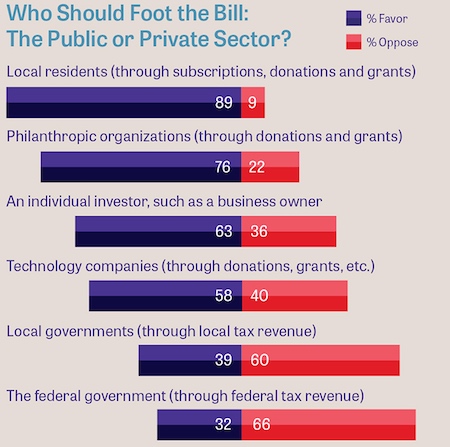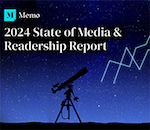Americans value the local news and want continued access to it, but few see it as a service worth paying for, according to a recent study by the Knight Foundation and opinion poll giant Gallup.
The study, which analyzed Americans’ perceptions and attitudes about local news organizations, found that an overwhelming majority of respondents (86 percent) believe everyone should have access to the news outlets in the areas in which they reside.
Moreover, more than three-quarters (76 percent) also consider local and state news organizations vital for keeping them informed, and more than half (59 percent) said they view their local newspaper as an important symbol of civic pride.
But when it comes to financially supporting to these organizations, most Americans’ behaviors don’t appear to match the value they place on local news. Only about one-in-five Americans (19 percent) said they subscribed or donated to a local news organization in the past year. Fewer still made a micropayment (5 percent) or paid for a day pass (6 percent) to access a news article.
Altogether, among the respondents polled who said they consider local newspapers to be vital, only 13 percent said they’d be “very likely” to give financial support to a failing newspaper in the area in which they live. Only a third (33 percent) of U.S. adults today subscribe to a local news outlet, according to the study, and only 39 percent are either currently subscribing to a news source or donated to nonprofit journalism in the past year.
While the Knight/Gallup study suggests that the local news industry in 2019 remains, at the very least, an economically flimsy enterprise, it also suggests that a general lack of awareness could be behind Americans’ reluctance to pay for the news services they claim to value. Incredibly, the study found that a majority of Americans (56 percent) erroneously believe that local news companies are doing well financially.
To make matters worse, when it comes to how Americans feel local news outlets should be funded, most are in agreement that economic support for the news should come from private sources as opposed to public institutions.
 |
Two-thirds of Americans (66 percent) said they oppose the idea of the local news receiving financial support from the federal government, and 60 percent said the same in regards to assistance from local governments.
Instead, while most Americans admit they don’t personally pay for the local news, nearly all (89 percent) still prefer local news to be funded by local residents. A smaller majority also support the idea of local outlets receiving financial support from philanthropic organizations (76 percent), individual investors (63 percent) and technology companies (58 percent).
Fewer than half of Americans (42 percent) believe this funding should be guaranteed, less than the number of Americans who support funding for local parks and recreational facilities (90 percent), local libraries (89 percent), local cultural and arts centers (77 percent) and local charities (51 percent).
In light of this, nearly half of Americans (47 percent) still said they consider local newspapers to be vital and should be financially preserved in some way, even if they can’t sustain themselves.
Finally, partisanship appears to offer one of the rare dividing factors insofar as whether someone is likely to pay for the news, their opinions regarding how it should be economically sustained or whether it deserves to be sustained it at all.
Democrats are much more likely today to pay a monthly or annual fee to access the news than Republicans (37 percent versus 25 percent), and Democrats are more than three times more likely to have donated to news organizations over the past year (30 percent versus eight percent).
Nearly three times more Democrats also favor the idea of local news organizations receiving financial support via local tax revenue than Republicans (70 percent versus 26 percent).
The Knight Foundation/Gallup report, “Putting a Price Tag on Local News,” surveyed nearly 3,000 U.S. adults between July and September. The study is part of a larger research series dedicated to understanding Americans’ evolving opinions of the media.


 Trump Media & Technology Group today reported a $58.2M net loss on $4.1M in 2023 revenues, a disclosure that drove its stock price down 22.6 percent to $47.96.
Trump Media & Technology Group today reported a $58.2M net loss on $4.1M in 2023 revenues, a disclosure that drove its stock price down 22.6 percent to $47.96. Barry Pollack, an attorney at Wall Street’s Harris St. Laurent & Wechsler, has registered Julian Assange as a client with the Justice Dept. “out of an abundance of caution.”
Barry Pollack, an attorney at Wall Street’s Harris St. Laurent & Wechsler, has registered Julian Assange as a client with the Justice Dept. “out of an abundance of caution.” Paramount Global to slash 800 jobs in what chief executive Bob Bakish calls part of an effort to “return the company to earnings growth"... Rolling Stone editor-in-chief Noah Shachtman is exiting at the end of the month due to disagreements with chief executive Gus Wenner over the direction the magazine is taking... The New York Times broke the $1 billion barrier in annual revenue from digital subscriptions in 2023... Press Forward is investing more than $500 million to strengthen local newsrooms.
Paramount Global to slash 800 jobs in what chief executive Bob Bakish calls part of an effort to “return the company to earnings growth"... Rolling Stone editor-in-chief Noah Shachtman is exiting at the end of the month due to disagreements with chief executive Gus Wenner over the direction the magazine is taking... The New York Times broke the $1 billion barrier in annual revenue from digital subscriptions in 2023... Press Forward is investing more than $500 million to strengthen local newsrooms. The majority of news articles are read within the first three days of publication, according to a recent report.
The majority of news articles are read within the first three days of publication, according to a recent report. The Los Angeles Times gives pink slips to 115 people or 20 percent of its newsroom staff... TIME is also laying off about 30 employees, which is approximately 15 percent of its editorial staff... The Baltimore Banner, which was launched by Stewart Bainum in 2022 after he failed to buy the Baltimore Sun, added 500 subscribers per day in the three days following Sinclair Broadcast Group's deal to purchase the Sun.
The Los Angeles Times gives pink slips to 115 people or 20 percent of its newsroom staff... TIME is also laying off about 30 employees, which is approximately 15 percent of its editorial staff... The Baltimore Banner, which was launched by Stewart Bainum in 2022 after he failed to buy the Baltimore Sun, added 500 subscribers per day in the three days following Sinclair Broadcast Group's deal to purchase the Sun.


 Have a comment? Send it to
Have a comment? Send it to 
No comments have been submitted for this story yet.